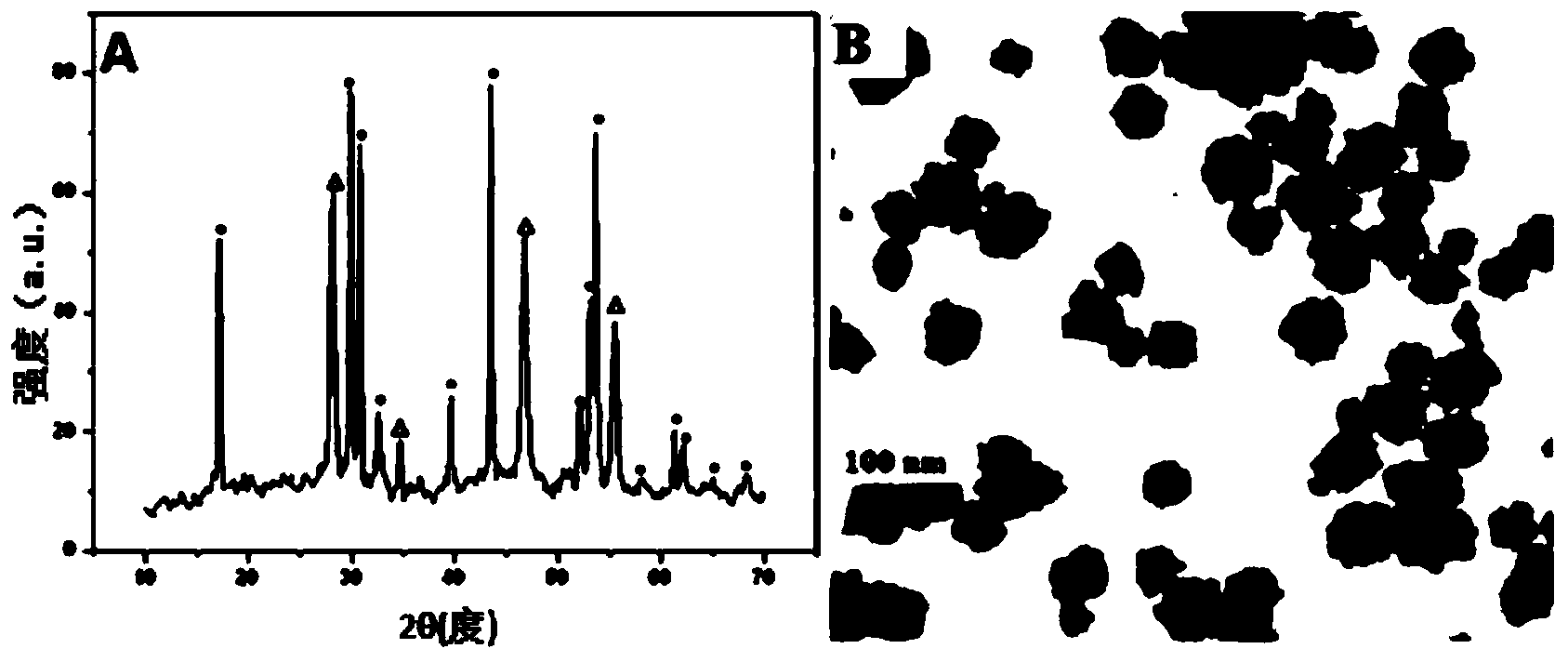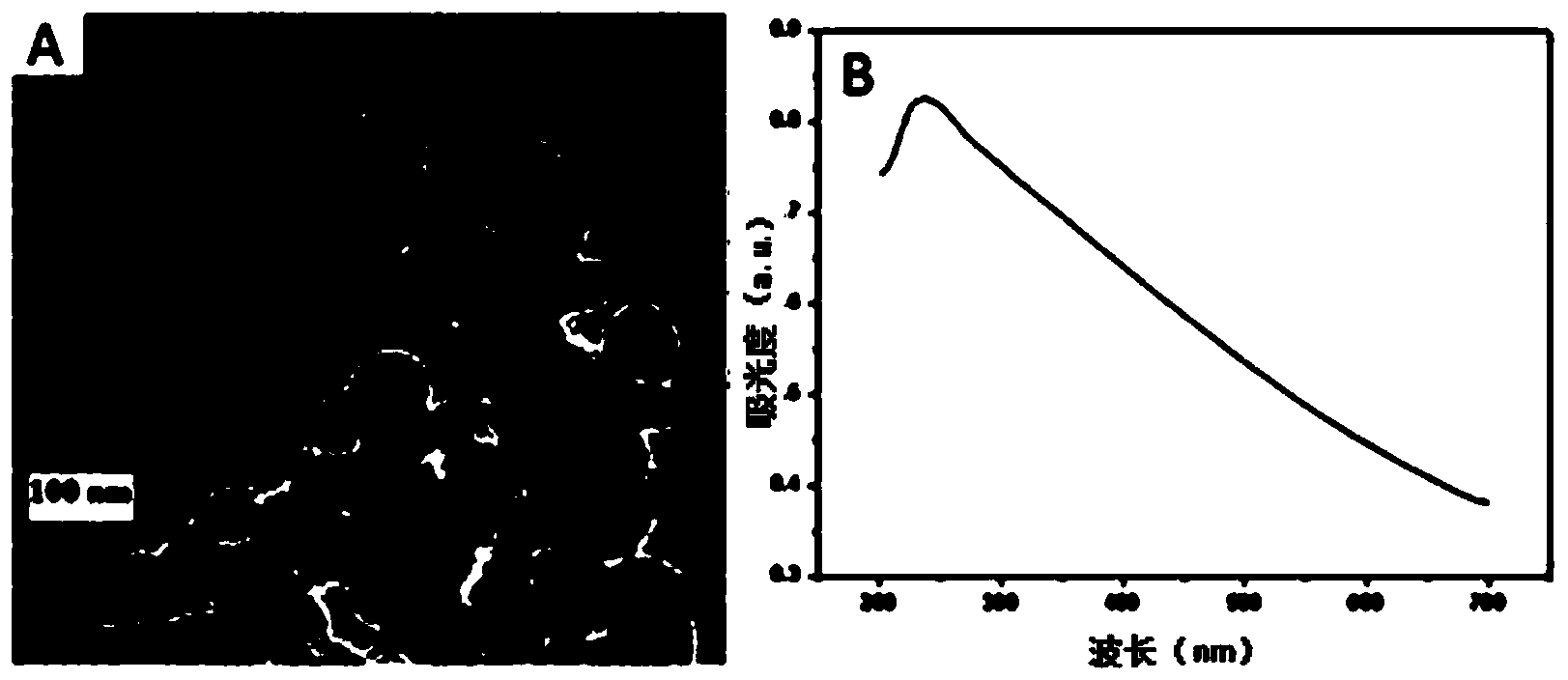Method for detecting upconversion fluorescence resonance energy transfer by using carbon nanomaterial as receptor
A fluorescence resonance energy, carbon nanomaterial technology, applied in luminescent materials, fluorescence/phosphorescence, material excitation analysis, etc., can solve the problems of affecting analysis and detection sensitivity, expensive instruments, and high detection costs, achieving excellent quenching ability, preparation Simple method and high sensitivity
- Summary
- Abstract
- Description
- Claims
- Application Information
AI Technical Summary
Problems solved by technology
Method used
Image
Examples
preparation example Construction
[0041] (1) Preparation of carbon nanoparticles: Weigh 8mg of candle ash and disperse in 20ml of mixed solvent (the volume ratio of ethanol and water is 1:1), sonicate for 5h, centrifuge at 3000rpm for 2min to remove large-sized particles, collect the supernatant, 6000rpm Centrifuge for 6 minutes to get 2 mg of black precipitate, which is carbon nanoparticles, and its characterization spectrum is shown in image 3 , where A is a transmission electron microscope image, and B is an ultraviolet-visible absorption spectrum; 2 mg of carbon nanoparticles were dispersed in 20 ml of solvent, and ultrasonically dispersed for 2 hours to obtain a black carbon nanoparticle solution with a mass fraction of 0.1 mg / ml.
[0042] (2) Preparation of graphene oxide (GO): Take 50mL concentrated sulfuric acid (concentration greater than or equal to 70%) and heat it to 90°C, add 10g K 2 S 2 o 8 and 10g P 2 o 5 , cooled to 80°C, until K 2 S 2 o 8 and P 2 o 5 After completely dissolving, slow...
Embodiment 1
[0045] Take 2mg / ml up-converting fluorescent nanomaterial-single-stranded nucleic acid (UCPs-ssDNA) solution 6uL, add different volumes of 0.1mg / mL 0.02% (wt) sodium dodecylbenzenesulfonate dispersed carbon nano Particle aqueous solution (SDBS-CNPs), add Tris-HCl (10mM, 150mM NaCl, pH7.4) buffer solution to a total volume of 400uL to obtain 8 groups of mixed solutions, the concentration of UCPs-ssDNA in each mixed solution is 0.03mg / mL , the concentrations of SDBS-CNPs were 0, 0.006, 0.012, 0.02, 0.03, 0.036, 0.04, 0.05mg / mL, and after incubation at 25°C for 1.5h, the upconversion fluorescence intensity was measured under a 980nm laser. When the concentration of SDBS-CNPs was 0.036 mg / ml corresponding to the fluorescence quenching efficiency of the mixture reached the maximum. Take 6 groups of mixtures containing 0.03mg / ml UCPs-ssDNA and 0.036mg / ml SDBS-CNPs and incubate at 25°C for 1.5h, then use one of them as a blank sample, and add different volumes of thrombin and serum t...
Embodiment 2
[0048] Take 5.6uL of 2mg / ml up-converting fluorescent nanomaterial-polypeptide (UCPs-peptide) solution, and add different volumes of 0.1mg / mL0.05% (wt) Triton-dispersed carbon nanoparticle aqueous solution (TritonX-100 -CNPs), add TCNB (pH7.5, 50mM Tris, 10mM CaCl 2 , 150mM NaCl, 0.05%Brij) buffer to a total volume of 400uL to obtain 8 sets of mixed solutions, the concentrations of UCPs-peptide in each mixed solution were 0.028mg / mL, and the concentrations of Triton X-100-CNPs were 0, 0.02, 0.03 , 0.04, 0.05, 0.06, 0.07 and 0.08mg / mL, after incubation at 20°C for 2 hours, measure the upconversion fluorescence intensity under 980nm laser, when the concentration of Triton X-100-CNPs is 0.05mg / ml, the corresponding fluorescence of the mixture The quenching efficiency reaches a maximum. Take 7 groups of mixtures containing 0.028mg / ml UCPs-peptide and 0.05mg / ml Triton X-100-CNPs and incubate at 25°C for 1.5h, then use one group as a blank sample, and add different volumes of human...
PUM
| Property | Measurement | Unit |
|---|---|---|
| Quality score | aaaaa | aaaaa |
Abstract
Description
Claims
Application Information
 Login to View More
Login to View More - R&D
- Intellectual Property
- Life Sciences
- Materials
- Tech Scout
- Unparalleled Data Quality
- Higher Quality Content
- 60% Fewer Hallucinations
Browse by: Latest US Patents, China's latest patents, Technical Efficacy Thesaurus, Application Domain, Technology Topic, Popular Technical Reports.
© 2025 PatSnap. All rights reserved.Legal|Privacy policy|Modern Slavery Act Transparency Statement|Sitemap|About US| Contact US: help@patsnap.com



